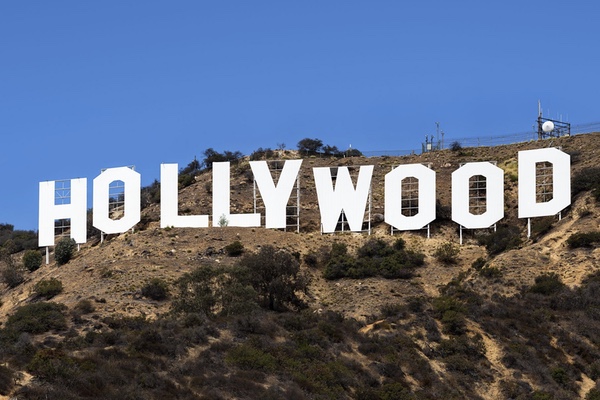The Fabled Hollywood Sign and a Great Depression Tragedy

Hollywood Sign - By Thomas Wolf, CC BY-SA 3.0
The huge, white H-O-L-L-Y-W-O-O-D sign that sits on a hill high over the film colony in Los Angeles is one of the most famous signs on earth, greeting visitors, and wanna-be stars, from all over the world. The sun shines brightly upon it in the daytime and the moon soars romantically over it at night. One night in September, 1932, Millicent “Peg” Entwistle, 24, one of the hundreds of thousands of young performers who hoped for stardom in Hollywood and never found it, leaped off the top of the “H” on the sign to her death. Her demise was symbolic of the failed struggles of all in the glitzy magical movie kingdom. Her obituary ran in the local newspapers, she was buried and then, like so many other hopefuls, forgotten.
Forty years later, Entwistle returned when songwriter Dory Previn, struck by her sad story, wrote an album of music about her in 1972 called Mary C. Brown and the Hollywood Sign. The album was later turned into a musical play. Now Previn’s tale about a tragic bit of Hollywood history is back yet again. The oddly staged but highly enjoyable play, that weaves a sad story not just about Entwistle but everybody in La La Land, just opened at the Firehouse Theater, 1609 W. Broad Street, Richmond, Virginia, and will be presented again there at a later date.
Mary C. Brown and the Hollywood Sign is a well-staged play with six actor/singers who perform the tale on a barren stage, rising and sitting on a row of chairs. The show opens with Kelsey Cordrey, as the starlet, singing Previn’s sad story of the girl who died. It sets the stage for an evening of songs by different performers whose lyrics tell the stories of not just Mary, but many men and women who went to Hollywood looking for glory and failed. Each of the performers does a sterling job of not only telling the story but reminding us, yet again, that Hollywood and the entertainment business is just as tentative – and often downright scary - today as it was in 1932, or in the 1970s, when Previn wrote the album.
It struck me that the play was particularly poignant because of the great success of the recent movie La La Land. In that film, the two protagonists, Emma Stone as the budding actress and Ryan Gosling as the would be jazz king, succeed. The Hollywood sign story is about those who fail.
Mary C. Brown, played well by Jessi Johnson, tells the story of Mary up until her death and in it tells the stories not just of failed actors, but black and white racial relationships that went badly and friendships that soured. The others join her in underscoring the sadness that can be filmland. There is Dan Cimo, who played a wonderfully stylized Hollywood agent, right down to the oversized sun glasses. He would make Mary famous. He would make everybody famous. There were the people promoting Jesus as the filmland redeemer and those who loved animals more than people because their movie grosses were higher. All of these actors were good, but particularly powerful was Matt Polson. He played an angry short person, a brash kid and a really ferocious King Kong, upset that in the land where people ruled he was put in a cage and seen as an oaf, while on Skull Island he ruled.
The format, with people getting up and then sitting down to sing their story (there is no dialogue) can put you off for a few moments, but after awhile you get used to it. The music by Previn is quite good – sweet and melodious at times and tough at others - although there are no hit songs. Many songs are begun by a particular singer and then he or she is backed up by a really sturdy and harmonious ensemble that is highly effective. The lyrics tell the story and the lyrics are layered to build up a massive tale and complex characters, all connected to that sign and the story of the woman who dove off of it back in 1932 (Entwistle was the only person who ever committed suicide there).
The disquieting, and ironic, aspect of Peg Entwistle’s story is that although she only had a bit part in one movie, Thirteen Women, released after her death, she had won an audition to star in a Los Angeles play and the letter confirming it arrived in her mailbox shortly after her suicide.
The production is good but there are three or four songs that do not tie into the story as well as they might. There also should be more stories about Mary, who was, after all the victim. Previn should also have included at least one song about how the Depression was affecting Hollywood and its studios in 1932, that might have been another factor in Entwistle’s death leap.
The Richmond cast is good. It includes Dan Cimo, Kelsey Cordrey, Rachel Rose Gilmour, Jessi Johnson, Matt Polson and Stevie Rice. The direction by George Boyd, on that barren stage, is quite imaginative.
The irony of the story is that the country is not just getting the little-known Hollywood sign story again, but getting it twice. A whole different production of the sign story, The Girl Who Jumped Off the Hollywood Sign, opens January 2, 2018, at the Theater for a New City, in New York. That production, starring Joanne Hartstone, is a one woman show with music. The story is the same, though - failure and death.
Hooray for Hollywood? Hardly.
PRODUCTION: The Richmond play, with music and lyrics by Dory Previn, is produced by the Firehouse Theater, with permission from Joby Baker. Musical direction: Matthew J. Pool, Choreography: Nicole Foret Oh, Musicians: Steve Belvin and Starlet Knight The play is directed by George Boyd.